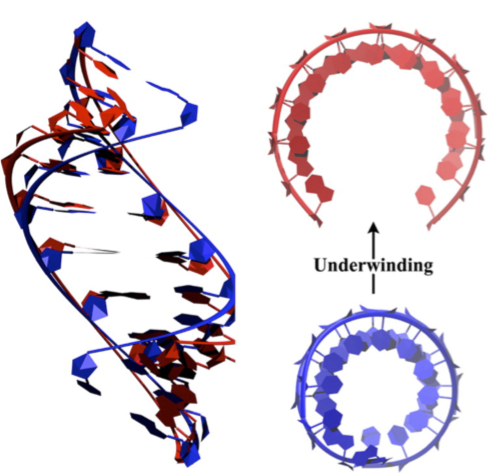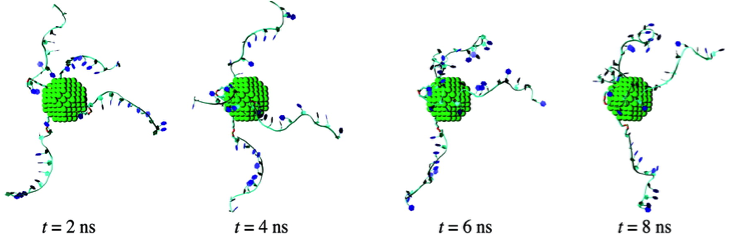Above: Snapshots of an 8ns simulation of DNA-functionalized gold nanoparticle demonstrating perpendicular arrangement of DNA on the surface.


The central role of DNA in molecular biology has made it a subject of extensive experimental and theoretical study. Researchers have been able to elucidate the structural characteristics that give rise to DNA’s unique thermodynamic, optical and electronic properties. As new technologies based on DNA interactions with organic and inorganic materials are developed, theoretical modeling can help answer some of the questions that arise about the structure-function relationships of DNA-based composite materials.
Our group uses molecular dynamics (MD) to study the structural basis for emergent properties DNA-based composite materials. We implement atomistic MD with nucleic-acid specific, empirical force fields (AMBER, CHARMM) to describe the complex electrostatic and steric environments that arise when DNA is densely arranged on a metal surface at high salt concentrations. We’ve gained insight into how these complex environments modulate the conformational ordering of the DNA changing its interactions with neighboring strands. Work is ongoing to establish how those structural differences affect thermodynamic properties such as DNA melting from the surface.

While the emphasis in the group has remained on DNA systems, work has also been done to explore the structural, sequence-dependent basis for thermodynamic properties of RNA and LNA (locked-nucleic acids). Recently, coarse-grained models of both DNA and RNA have been developed and utilized by the group to understand the thermodynamic behavior of oligonucleotides grafted on the surface of nanoparticles.
Eric Cheng-Tsung Lai, postdoctoral fellow
Lam-Kiu Fong, 4th year graduate student joint with Chad Mirkin
Recent Publications:
Lee, O.S.; Schatz, George C.“Molecular dynamics simulation of DNA-functionalized gold nanoparticles” J. Phys. Chem. C 2009, 113, 2316–2321.
Kohlstedt, K.L.; Olvera de la Cruz, M.; Schatz, George C., “Controlling Orientational Order in 1-D Assemblies of Multivalent Triangular Prisms”. J. Phys. Chem. Let. 2013, 4, 203-308.
Randeria, P.S.; Jones, M.R.; Kohlstedt, K.L.; Banga, R.J.; Olvera de la Cruz, M.; Schatz, George C.; Mirkin, C.A. “What controls the hybridization thermodynamics of spherical nucleic acids?” J. Am. Chem. Soc. 2015, 137, 3486-3489.
Yildirim, I.; Kierzek, E.; Kierzek, R.; Schatz, George C., “Interplay of LNA and 2 ‘-0-Methyl RNA in the Structure and Thermodynamics of RNA Hybrid Systems: A Molecular Dynamics Study Using the Revised AMBER Force Field and Comparison with Experimental Results”. J. Phys. Chem. B 2104, 118, 14177–14187.
